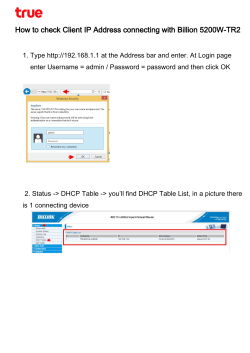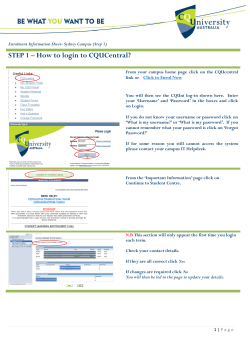
Cybersecurity Brief - University Archives & Records Management
Protecting University Records, Important Data and Personal Information Helpful cybersecurity tips… Presentation for Conference of Office Professionals Bob Turner Chief Information Security Officer UW-Madison April 15, 2015 What is Cybersecurity? Cyber Security is a set of principles and practices designed to safeguard computing assets and online information against threats. 2015 CIO Survey Is your organization will be the target of more cyberattacks in 2015 when compared to 2014. Impact on work • How would you know whether an email sent to you with an attachment is free from viruses? • How do you secure sensitive data you send via email? • What steps would you take to secure your computer from malware? • What does the phrase“ safely manage your password” mean to you? Steps to be Secure on the UW Network Safeguard valuable information. Find it. Delete it. Protect it. Use Identity Finder to locate and protect your restricted data. Stay virus-free. Use Symantec Endpoint Protection (Antivirus) to protect against and remove existing viruses and malware. Fix weak spots. Use Secunia PSI to quickly identify out-of-date programs and find updates (Windows machines only). Protect yourself on open networks. Use WiscVPN for secure surfing on open networks. Login with your UW NetID. Any other IT security questions? Contact security@wisc.edu. Security Risks • Loss of vital records and research • Compromised Personally Identifiable Information (PII); PII data includes name, SSN, Driver’s License, credit information, bank accounts • Identity Theft - computer intruders intent on stealing your personal information to commit fraud or theft Security Risks (cont’d) • Compromised computer; A computer experiencing unexpected and unexplainable • Disk activities • Performance degradation • Repeated login failure or connections to unfamiliar services • Third party complaint of a suspicious activity Or a stolen or lost computer… • The use of unsecure settings of Peer to Peer File Sharing applications. What is Restricted Data? • Social Security Number (SSN) • Driver’s License Number or State ID Number • Financial Account Number (including credit/debit card) or any security code, access code of password that would permit access to an individual’s financial account • Deoxyribonucleic Acid (DNA) Profile as defined in S. 939.74 (2d) (a) • Unique Biometric Data, including fingerprint, voice print, retina or iris image or any other unique physical representation • Protected health information (PHI) including any information about health status, provision of health care, or payment of health care Important IT Security Threats Intrusion – Unauthorized individuals trying to gain access to computer systems in order to steal information Phishing – The practice of using email or fake website to lure the recipient in providing personal information Virus, Worm, Trojan Horse (Malware) – programs that infect your machine and carry malicious codes to destroy the data on your machine or allow an intruder to take control over your machine Spyware – software that sends information from your computer to a third party without your consent Spam – programs designed to send a message to multiple users, mailing lists or email groups Security Measures 1. Safely mange your password 2. Safely manage your email account 3. Secure your computer 4. Avoid risky behavior online 5. Protect the data you are handling 6. Be aware of security guidelines, policies, and procedures Password Safety • • • • • • • Create and maintain a strong password Consider using a passphrase Avoid sharing your password with any one Avoid reusing the same password for multiple accounts Avoid storing your password where others can see it, or storing it electronically in an unencrypted format (e.g. a clear text file) Avoid reusing a password when changing an account password Do not use automatic logon functionality E-Mail Safety • All “university business” correspondence should be sent from an official UW-Madison email address. • Avoid using personal accounts for business workflow • Save copies of important outgoing email • Avoid opening attachments from an untrusted source • Avoid clicking on links in an email from an untrusted source • Be wary of email phishing scams • Avoid providing your user ID and password or other confidential information in an email or in a response to an email • Save personal messages in a designated folder • Organize your email and files by project or work type • Request additional file storage for projects with large number of files Securing your computer • Lock your computer when not attended • Log off or shutdown when going home • Disconnect your computer from the wireless network when using a wired network • Patch and update your operating system • Install and update your anti-virus and anti-malware with the latest security definitions • Create a unique user ID when sharing a computer with others • Enable pop-up blocker on your browser • Make an informed and rational decision prior to installing or downloading software on your computer • Lock your office when you leave Avoid risky behavior online • Be wary of phishing scams • Be cautious when handling attachments and links in email, chatrooms or instant messages (IM) • Avoid responding to questions via pop-up windows, or click on links in a pop-up window • Be cautious when using Peer to Peer File Sharing applications • Be cautious when browsing the web. One spelling mistake can direct you to undesired websites Questions? • bob.turner@wisc.edu • 608-263-2477 • Computer Science Rm 2112 14
© Copyright 2025










